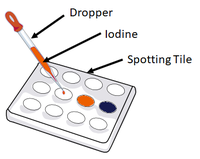Difference between revisions of "Method"
(→Examples) |
(→About Methods) |
||
| Line 40: | Line 40: | ||
===About Methods=== | ===About Methods=== | ||
| − | A [[method]] is written for an [[experiment]] so that others can [[reproduce]] the [[experiment]]: | + | :A [[method]] is written for an [[experiment]] so that others can [[reproduce]] the [[experiment]]: |
| − | *To see if the [[experiment]] is [[valid]]. | + | :*To see if the [[experiment]] is [[valid]]. |
| − | *To determine if the same [[result]]s can be achieved everywhere. | + | :*To determine if the same [[result]]s can be achieved everywhere. |
| − | *To spot any major [[error]]s in the [[experiment]] that may cause [[Reliability|unreliable]] [[result]]s. | + | :*To spot any major [[error]]s in the [[experiment]] that may cause [[Reliability|unreliable]] [[result]]s. |
: [[Method]]s should be written in the form of "writing to instruct". They do not use any personal pronouns; I, you, he, she, we, or they. | : [[Method]]s should be written in the form of "writing to instruct". They do not use any personal pronouns; I, you, he, she, we, or they. | ||
: A [[method]] often has a [[diagram]] with it to identify how to set up the [[experiment]] or name the pieces of [[equipment]]. | : A [[method]] often has a [[diagram]] with it to identify how to set up the [[experiment]] or name the pieces of [[equipment]]. | ||
Revision as of 09:36, 21 March 2019
Contents
Key Stage 2
Meaning
A method is the set of instructions you follow to complete an experiment.
About Methods
- A method can be followed if you are trying to copy another person's experiment.
- A method can be written if you have created your own experiment and want other people to be able to copy it.
- Methods should be written in the form of "writing to instruct". They do not use any personal pronouns; I, you, he, she, we, or they.
- A method often has a diagram with it to identify how to set up the experiment or name the pieces of equipment.
Examples
| Diagram | Method | Results |
Method
|
Key Stage 3
Meaning
A method is the set of instructions that are followed to complete an experiment.
About Methods
A method is written for an experiment so that others can reproduce the experiment:
- To see if the experiment is valid.
- To find out if you get the same results everywhere.
- To spot any major errors in the experiment that may cause unreliable results.
- Methods should be written in the form of "writing to instruct". They do not use any personal pronouns; I, you, he, she, we, or they.
- A method often has a diagram with it to identify how to set up the experiment or name the pieces of equipment.
Key Stage 4
Meaning
A method is the set of instructions that are followed to complete an experiment.
About Methods
- A method is written for an experiment so that others can reproduce the experiment:
- To see if the experiment is valid.
- To determine if the same results can be achieved everywhere.
- To spot any major errors in the experiment that may cause unreliable results.
- Methods should be written in the form of "writing to instruct". They do not use any personal pronouns; I, you, he, she, we, or they.
- A method often has a diagram with it to identify how to set up the experiment or name the pieces of equipment.

